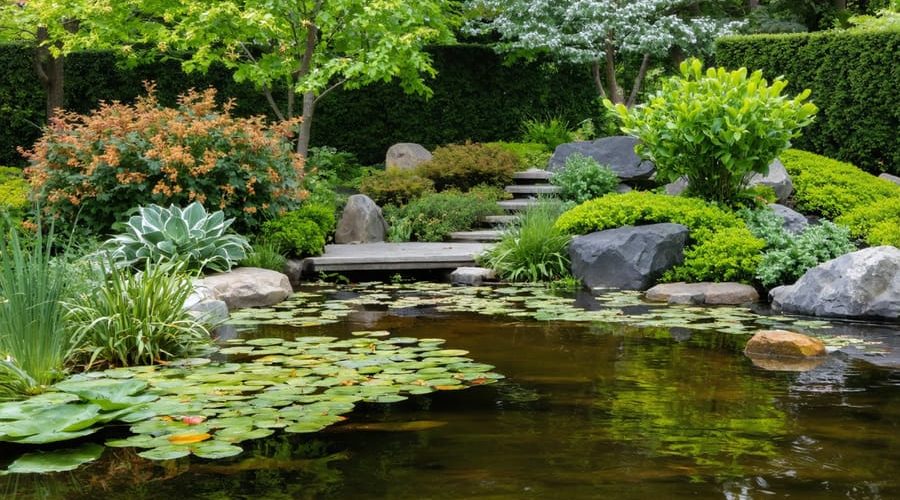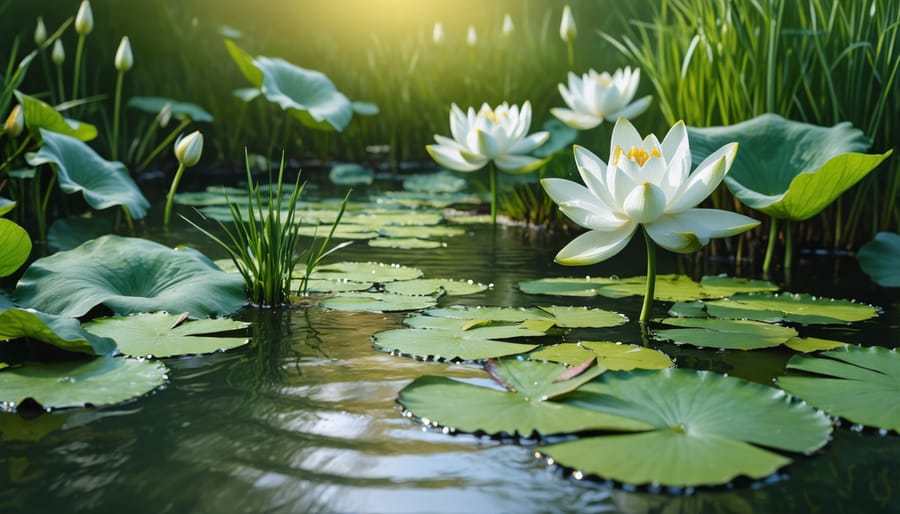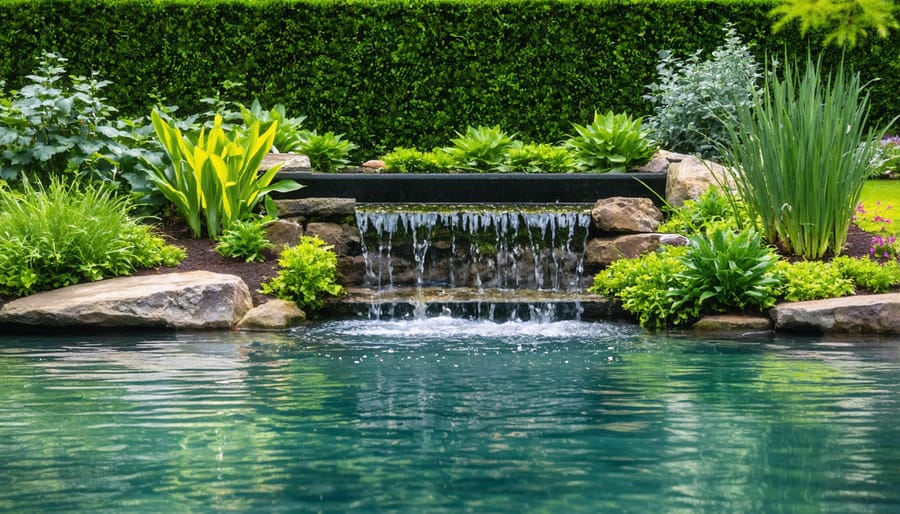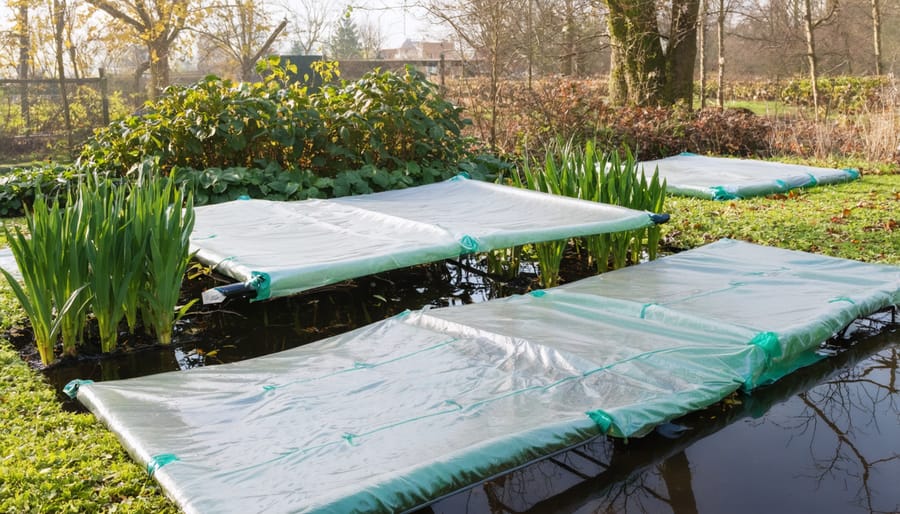
Perfect Water Garden Plant Schedule: Keep Your Aquatic Plants Thriving Year-Round
Master your plant watering schedule by observing soil moisture levels daily – stick your finger one inch deep into the soil and water only when it feels dry. Group plants with similar water needs together to create a thriving water garden and streamline maintenance. Adjust watering frequency based on seasonal changes: increase during hot, dry periods and reduce during cooler, humid weather. Water deeply in the early morning to minimize evaporation and prevent fungal growth, ensuring roots grow strong and deep. Track your plants’ specific needs using a simple calendar system – note which plants show signs of stress (wilting, yellowing) and adjust their schedule accordingly. Different plants require varying amounts of water: succulents thrive with minimal irrigation while tropical varieties need consistent moisture. Monitor outdoor container plants more frequently, as they dry out faster than in-ground plantings and may need daily watering during peak summer months.
Spring Awakening: March to May

Early Spring Plant Selection
As the first signs of spring emerge, it’s the perfect time to introduce early-blooming aquatic plants to your water garden. Start with hardy varieties like Marsh Marigolds, which burst into brilliant yellow flowers as early as March. These resilient plants can handle occasional frost and provide that first splash of color your pond needs.
Water Iris is another excellent choice for early spring, with varieties that bloom from late March through May. Their vertical growth adds structural interest, while their roots help filter the water naturally. Consider adding Sweet Flag (Acorus) for its attractive grass-like foliage that emerges early in the season.
For floating plants, Water Hawthorne is an ideal early springer, producing fragrant white flowers that float delicately on the water’s surface. If you’re working with shallow margins, Primula japonica (Japanese Primrose) thrives in these conditions and offers stunning pink to deep red blooms.
When selecting your early spring plants, consider their mature size and growth habits. Place taller plants like Rush and Cattails toward the back of your pond, while keeping lower-growing varieties like Creeping Jenny at the front edges. This creates a natural-looking transition and ensures all plants remain visible as they grow.
For best results, plant these early bloomers as soon as ice threats have passed, typically when water temperatures consistently stay above 50°F (10°C). This gives them time to establish strong root systems before the main growing season begins.
Spring Watering Patterns
Spring brings renewed vitality to your garden, and adjusting your watering schedule is crucial for supporting this energetic growth phase. As temperatures warm up and daylight hours increase, your plants will need more frequent watering to support their developing leaves and flowers.
Start by checking soil moisture every 2-3 days in early spring. Insert your finger about an inch into the soil – if it feels dry at this depth, it’s time to water. Most plants will need watering 2-3 times per week during this season, but always monitor your specific plants’ needs rather than following a rigid schedule.
Water deeply in the morning to allow proper absorption before evening temperatures cool. This timing helps prevent fungal growth and ensures plants have access to moisture throughout the day when they’re most active. Apply water at the base of plants rather than overhead to minimize leaf diseases.
For newly planted additions to your garden, maintain consistently moist (but not waterlogged) soil for the first few weeks to help establish strong root systems. Container plants typically need more frequent watering than those in the ground, sometimes daily during warm spring spells.
Remember to adjust your watering patterns during spring rains. While natural precipitation is beneficial, too much water can be as harmful as too little. Install a rain gauge to track rainfall and adjust your watering schedule accordingly.
Summer Growth: June to August
Summer Plant Rotation
As summer temperatures rise, it’s time to introduce vibrant, heat-loving varieties to your water garden. Start by gradually introducing tropical water lilies and lotus plants, which thrive in warm water and provide stunning blooms throughout the season. These summer favorites require consistent water levels and plenty of sunlight to reach their full potential.
When rotating your summer plants, pay special attention to water depth. Floating plants like water hyacinths and water lettuce multiply quickly in warm conditions and help shade the water, reducing algae growth. Position these at the surface while keeping deeper-water plants like lilies at their preferred depths of 12-18 inches.
Monitor water levels more frequently during summer, as evaporation increases with higher temperatures. Top up your pond regularly, preferably in the morning or evening to minimize shock to the plants. Consider installing an automatic top-up system if you’re planning extended summer trips.
For optimal growth, fertilize summer-blooming plants every two weeks using aquatic plant tablets. Place these directly in the planting containers, avoiding direct water contact to prevent nutrient overload and algae issues.
Remember to thin out rapidly growing plants regularly. This prevents overcrowding and ensures proper water circulation. Remove about one-third of floating plant coverage weekly, and divide marginal plants when they become too dense.
As part of your rotation schedule, introduce new varieties gradually over several weeks. This allows the pond’s ecosystem to adjust and helps maintain water quality. Keep some spring plants during the transition to provide continuous interest and support for wildlife visiting your water garden.
Heat Management Strategies
During hot weather, plants face increased water stress due to higher evaporation rates and intensified sunlight. Understanding how to manage these challenges is crucial for maintaining healthy plants. Start by adjusting your watering schedule to early morning or late evening hours when temperatures are cooler, reducing water loss through evaporation.
Consider mulching around your plants with organic materials like straw or wood chips. This creates a protective barrier that helps retain moisture and keeps root zones cooler. For container plants, you might want to group them together to create a microclimate that maintains humidity and reduces water loss.
Managing water levels during heat waves requires extra attention. Install moisture meters to monitor soil conditions and avoid both under and overwatering. During extreme heat, consider providing temporary shade using shade cloth or umbrellas, especially for sensitive plants.
Water deeply but less frequently to encourage deeper root growth, which helps plants become more resilient to heat stress. A good rule of thumb is to water until the soil is moist 6-8 inches deep. You can check this by inserting a long screwdriver into the soil – it should slide easily through moist soil.
For potted plants, consider using self-watering containers or water-retaining crystals to maintain consistent moisture levels. Also, remember that different plants have varying heat tolerances, so adjust your watering schedule accordingly. Signs of heat stress include wilting, leaf curling, and browning edges – increase watering gradually if you notice these symptoms.

Fall Transition: September to November
Fall Plant Selection
As temperatures begin to drop, preparing your garden for fall means selecting plants that can withstand cooler conditions. Hardy water lilies, rushes, and sedges are excellent choices that continue to thrive as autumn approaches. Look for varieties like the Leopard Plant (Ligularia) or Japanese Forest Grass, which add beautiful color while being tough enough to handle temperature changes.
When choosing fall plants, focus on those labeled as “cold-hardy” or suitable for your specific climate zone. Deep-water plants should be gradually moved to lower depths where the water stays warmer. Consider adding marsh marigolds or water forget-me-nots, which naturally bloom in cooler weather and provide stunning autumn displays.
Remember to incorporate plants with different heights and textures. Tall grasses like Northern Sea Oats create visual interest and movement, while low-growing creeping Jenny offers ground coverage that transitions well into winter. As you select your fall varieties, think about winter protection too – choose plants that can either be easily moved indoors or those that can overwinter in place with minimal protection.
For best results, group plants with similar cold tolerance together. This makes it easier to protect sensitive varieties and maintain appropriate water levels for each group as temperatures fluctuate during the transition to winter.
Autumn Watering Adjustments
As temperatures drop and days grow shorter, your plants’ watering needs change significantly. During autumn, most plants enter a period of slower growth or dormancy, requiring less frequent watering than in summer. Monitor soil moisture by inserting your finger about an inch deep into the soil – if it feels dry at this depth, it’s time to water.
For outdoor container plants, reduce watering to once every 7-10 days, depending on rainfall. Indoor plants typically need water every 10-14 days during this season. Pay special attention to plants near heating vents, as artificial heat can cause soil to dry out more quickly.
Consider the following autumn adjustments:
– Water in the morning to allow absorption before cooler evening temperatures
– Reduce water volume by about 25-30% compared to summer amounts
– Check weather forecasts and skip watering if rain is expected
– Remove fallen leaves from containers to prevent moisture retention issues
– Use mulch to help retain moisture and regulate soil temperature
Remember that different plants have varying needs. Succulents and cacti may only need water every 3-4 weeks, while tropical plants might still require weekly watering. Always check individual plant requirements and adjust accordingly.
If you’re experiencing an unusually warm autumn, you may need to maintain a more frequent watering schedule until temperatures consistently cool down.
Winter Care: December to February
Winter Plant Protection
As temperatures drop, protecting your plants from freezing becomes crucial. Start by winter-proofing your water garden before the first frost arrives. Move sensitive container plants to sheltered areas or indoors, and consider using frost protection covers for those that must remain outside.
Reduce watering frequency during winter, but don’t stop completely. Plants still need moisture, just less of it. Water early in the day when temperatures are higher, allowing plants to absorb moisture before freezing temperatures set in. Check soil moisture levels regularly by inserting your finger about an inch deep – if it feels dry, it’s time to water.
For potted plants, add a layer of mulch to insulate roots and retain moisture. Consider grouping containers together to create a microclimate that helps protect against harsh winds and temperature fluctuations. Keep an eye on weather forecasts and provide extra protection during severe cold snaps by covering plants with horticultural fleece or bubble wrap, ensuring the covering doesn’t touch the foliage directly.

Planning for Spring
As winter winds down, it’s time to plan your spring watering schedule for optimal plant growth. Start by assessing your garden’s layout and creating a detailed map of different plant zones based on water needs. Early spring bloomers like tulips and daffodils will need more frequent watering as they emerge, while established perennials can manage with less.
Consider factors like soil type, sun exposure, and typical rainfall patterns in your area when developing your schedule. Group plants with similar water requirements together to make watering more efficient. For new plantings, plan to water more frequently during their establishment period – typically every 2-3 days for the first few weeks.
Set reminders on your phone or calendar for different watering zones. Morning watering is best, allowing plants to dry before evening and reducing disease risk. Don’t forget to account for spring rainfall in your schedule – a rain gauge can help track natural precipitation.
As temperatures warm up, gradually adjust your watering frequency. Keep a garden journal to track what works best for your specific plants and conditions. This documentation will prove invaluable for future growing seasons.
Remember that successful plant watering is all about flexibility and observation. While the seasonal guidelines we’ve discussed provide a solid foundation, your local climate, rainfall patterns, and specific plant varieties will ultimately determine the perfect watering schedule for your garden.
Pay close attention to how your plants respond throughout the year. In spring, gradually increase watering as plants emerge from dormancy. Summer demands vigilant moisture monitoring, especially during heat waves. Fall requires a careful reduction in watering to prepare plants for winter, while winter watering should be minimal for most species.
Don’t hesitate to adjust your watering schedule based on environmental factors. Factors like humidity, wind exposure, soil type, and plant maturity all play crucial roles in water needs. Consider investing in simple tools like moisture meters or rain gauges to help fine-tune your approach.
Most importantly, trust your instincts and learn from experience. Keep a garden journal to track watering patterns and plant responses throughout the seasons. This personal record will become an invaluable resource as you develop your green thumb.
With patience and attention, you’ll develop an intuitive understanding of your garden’s water needs. Remember that even experienced gardeners continually adjust their techniques – gardening is a journey of constant learning and adaptation to nature’s rhythms.
